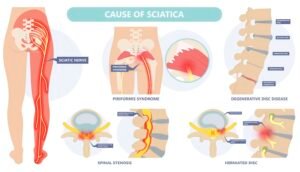
What is Sciatica
Sciatica refers to pain that radiates along the path of the sciatic nerve, typically from the lower back down one leg. It’s often caused by a herniated disk, bone spur on the spine, or spinal stenosis, compressing the nerve. Symptoms include sharp pain, tingling, or numbness in the affected leg, sometimes accompanied by weakness. Treatment may involve rest, hot or cold packs, pain relievers, physical therapy, and in severe cases, surgery. Managing underlying conditions and adopting good posture can help prevent recurrences. Seek medical advice for persistent or severe symptoms to determine the best course of action. It is caused by injury to or pressure on the sciatic nerve. Sciatica is a symptom of a medical problem. It is not a medical condition by itself.
What is the main cause of sciatica?
Sciatica occurs when the nerve roots to the sciatic nerve become pinched. The cause is usually a herniated disk in the spine or an overgrowth of bone, sometimes called bone spurs, on the spinal bones. More rarely, a tumor can put pressure on the nerve.
What are the 4 types of sciatica?
- Acute sciatica. Acute sciatica is a recent onset, 4 to 8-week duration of sciatic nerve pain.
- Chronic sciatica.
- Alternating sciatica.
- Bilateral sciatica.
- Lower back pain.
- Pain in the rear or leg that is worse when sitting.
- Hip pain.
- Burning or tingling down the leg.
- Weakness, numbness, or a hard time moving the leg or foot.
- A constant or shooting pain on one side of the rear, leg, or hip.
Sciatica usually heals on its own with rest and time. To help relieve the pain, treatment may include: Nonsteroidal anti-inflammatory (NSAIDS) medicines such as ibuprofen. Heat or cold applied to the sore muscles.
- Lifting both legs off the ground.
- High impact training.
- Squatting.
- Twisting or rotating the torso.
- Bending forward with straight legs.
Skip The Waiting Room!
Register Online Before You Arrive.
We have up to date schedules, contact information, & let you book appointments online.


